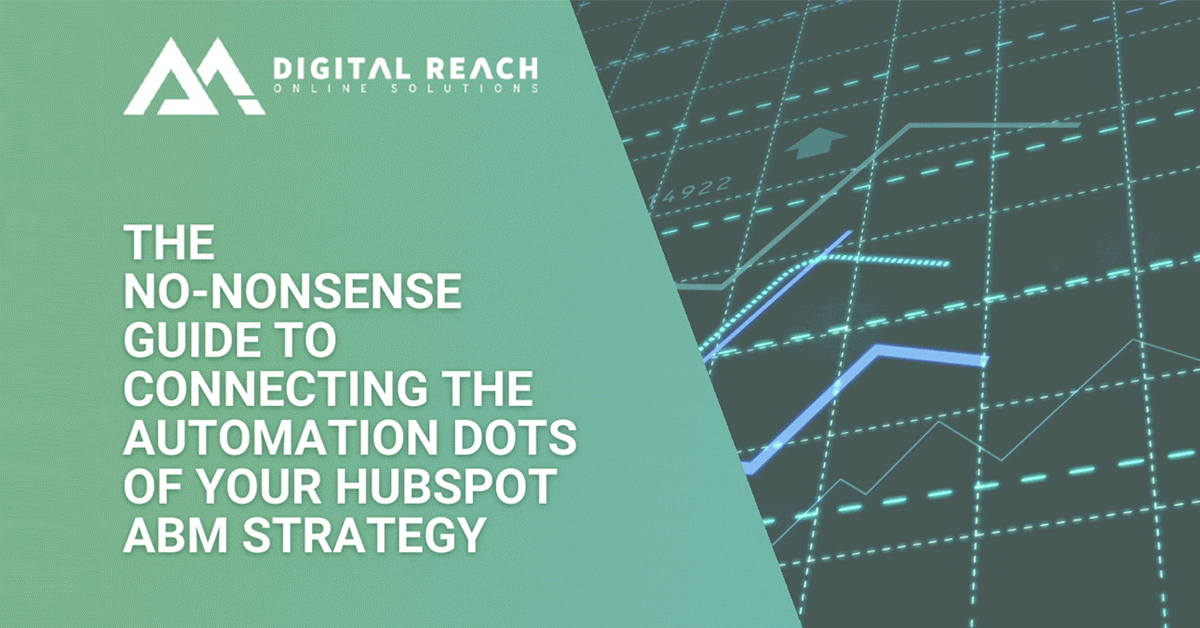Optimizing Content Marketing with AI-Driven CMS
Unlock the future of marketing efficiency and creativity with AI-powered content management systems.

A HubSpot Partner and Google Partner agency offering marketing automation services, digital marketing, and CRM customization for businesses of all sizes.
11 min read
![]() Aurora
:
Feb 8, 2022 7:00:00 AM
Aurora
:
Feb 8, 2022 7:00:00 AM

Have you ever worked hard on a well-planned marketing campaign that resulted in 2% of your target audience converting? If the answer is yes, you’re not alone. Most businesses have experienced this unfortunate outcome at one time or another. Those who aren’t careful can even experience a situation where they don’t get any conversions at all.
This is where Account-Based Marketing (ABM) comes in. With ABM, marketers can target the most qualified prospects, avoiding those who are less likely to convert. What’s more, when given the right nurturing and support, these target customers will deliver the best results for your business.
According to HubSpot, in 2021, 70% of marketers report using ABM, up 15% from 2020.
No doubt, ABM strategies are amazing, especially for B2B businesses but building a strategy and being able to deploy it using automation takes some fine-tuning and can be a bit of a challenge to start.
In addition, making sure your sales and marketing teams are aligned is a critical component of ABM - but also the most challenging. Why? Because there are so many tools that you can use.
To be successful with ABM, you'll need everybody participating in this strategy to be on the same page. And the key to cohesiveness & ABM success is to have the right automation set up - otherwise, you'll fail to create any sort of momentum behind your efforts and end up with a strategy that doesn't get much traction.
That’s what we’ll cover in this article. We'll show you how the right automation process works and, ultimately, show you how to connect all the automation dots of your ABM strategy via HubSpot.
.png?width=601&name=The%20no-nonsense%20guide%20to%20connecting%20the%20automation%20dots%20of%20your%20hubspot%20strategy%20(1).png)
For anyone new to ABM, here’s a quick answer:
Account-based marketing (ABM) is a strategic approach to digital marketing. ABM focuses on targeting your most valuable customers and prospects based on the specific needs of each customer.
In its most basic form, ABM requires companies to build their own customer database (a.k.a., "accounts") as a foundation for their marketing efforts. Taken together, these companies make up an "account" that you are trying to reach and win over for your own products and services.
ABM is actually a lot like the direct mail of the digital age. It's a targeted, strategic approach to marketing that focuses on individual accounts at specific companies instead of trying to reach a larger, broader audience.
For example, if you're selling software for restaurants, you might target CMOs at 100 restaurant chains. By going after the executives who make decisions about new tools and products for their companies, you're putting yourself in front of decision-makers who can have the biggest impact on your business.
Why Does Account-Based Marketing Work?
One of the main benefits of ABM is that you're only going to spend time reaching out to people who have a good chance of buying from you in the first place. This means that you're not wasting time or money by targeting the wrong people (bad or dead leads). You'll be able to focus on real leads rather than spending time on cold calling, advertising, and other forms of outreach to a broad market that won't necessarily bring in any business anyway.

Since ABM requires highly-targeted strategies - at first glance, it might feel like there is overwhelmingly too much data on too many tools that you need to run, manage and track.
Timing is also key. For instance, let's say you're using intent data or surge data from ZoomInfo, Bombora, G2, and Gartner - you've got to act on that data at the right time. And when you act on that data, not only do you have to change how you're targeting that audience and how large that audience is with air cover, for instance, but you also need to change a whole bunch of other activities and labels in your CRM and tasks that you're completing, etc.
This may seem like a labor-intensive barrier to entry. But rest assured, with the right tools and automation in place, you can successfully find your way around this by making sure you have all the “ingredients” for the perfect ABM “recipe” before you start implementation/deployment.
Here’s a mini, ABM strategy pre-launch playbook using HubSpot:
A prerequisite for any ABM strategy, before you can market and sell to your ideal customer, you need to define who your ideal customer is. That’s exactly what an Ideal Customer Profile (ICP) is. HubSpot defines it as a “fictitious company that has all of the qualities that would make them the best fit for the solutions you provide.”
ICPs are also different from buyer personas. Buyer personas are fictitious individuals based on a person's job title or function within an organization while ICPs are ideal profiles of companies that you’re looking to influence and close.
By creating an ICP, you’re informing your sales and marketing teams who the best people to contact/sell to in the company you’re targeting. After all, the whole bottom line of ABM marketing is that you don’t market to everyone, but rather - directly target the key people (decision makers) in the company.
.png?width=629&name=ICP%20Infograph%20(1).png)
The best way to identify ICPs is through a combination of firmographic, demographic, psychographic and technographic information to dial down the characteristics of the company you’re looking to target. Once you have your ICPs, you’ll then need to break them down into tiers. There’s no hard and fast rule for ICP tiering but HubSpot segments its ABM features into three tiers.
As an example, we would call a Series C company a Tier 1 and a Seed Stage company Tier 3. This would be based on size, revenue, and funding.
Once you have your ICP tiers ready, you can now push them into HubSpot and then add custom workflows that will automate your ABM play. Through HubSpot, you can automatically deliver emails, nurture ads and trigger sales sequences that are relevant to that particular audience/tier.
Identifying your ICPs, breaking them down into tiers and then pushing those tiers into HubSpot takes a coordinated approach that will take up a significant amount of time and effort for both your sales and marketing teams but if you’re after ABM success, it’s a necessary exercise.
In addition, once you’ve pushed your ICP tiers into HubSpot, the actions you took can be easily cloned, which means you don’t have to rebuild everything from scratch if you want to reconfigure or add data.
Benefits of ICP Tiers
How can Digital Reach help you?
You’ll want to make sure that you’re making the most of your ICP. This requires a solid set of digital marketing tools, a strong team, and a lot of planning - all of which Digital Reach can offer you. If you don’t currently have an ICP strategy in place, we can help you create one or update/strengthen one that you already have in place.
Want to talk more about how Digital Reach can elevate your ABM strategies?
Book a call with us here: digitalreachos.com/contact-us/.
Since automation and data are key in ABM success, you’ll need the right tools to assist you in setting up your ICP tiers. Tools for getting the information you need around which accounts you’re going to be targeting, how you’re going to categorize them into lists, and what conditions you’re going to have to meet to serve them ads, put them in sales sequences, etc.
Bombora's real-time, collaborative platform is an ideal way to discover, populate and manage target accounts.
ZoomInfo's account data is integrated directly into Bombora, which makes it easy to use ZoomInfo data in ABM campaigns.
You can use Bombora as your central data hub to perform a full target account discovery process, including:
Once you have a list of target accounts, Bombora helps you keep track of your activities toward those accounts.
We spoke of your ICP tiers above, right? Bombora & ZoomInfo can build your Ideal Customer Profile tiers and push those tiers into HubSpot automatically and get them on their proper lists which then allows you to deploy other automation, but, more importantly, ZoomInfo & Bombora are also going to allow you to push audiences into HubSpot that are surging for specific intent topics. What does this mean? Let’s unpack that by defining 3 key terms straight from Bombora’s FAQ pages:
Company Surge® data is Bombora's patented solution for identifying businesses interested in specific B2B products or services. Company Surge® identifies when a business is increasing research activity or content consumption on a product or service compared to its historical baseline, which is a strong indicator of B2B purchase intent.
Intent data is a broad term for data collected about a business web user’s observed content consumption behavior. Intent data is important in B2B marketing, because it helps characterize your target audience. If you're selling to businesses, then understanding the business and purchase intent of your customers can help guide every aspect of your marketing efforts: messaging, products and campaigns.
A Surge Score indicates the extent to which a company is surging on a specific topic compared to its historical baseline. Scores range from 0 to 100. A score of 50 equals average consumption. Surging companies are those that have scores above 60.
There are many factors that contribute to the way Bombora’s models calculate the Surge score including:
a. Topic consumption by interactions - the number of interactions from a business in the last 3 weeks compared to the previous 12 weeks of historical data.
b. Topic consumption by unique users - the number of unique individuals from a business researching relevant topics in the last 3 weeks compared to the previous 12 weeks of historical data.
c. Topic relevancy weight - a measure of the content piece's 'denseness' in the topic of interest, i.e. is the topic the focus of the content piece or mentioned briefly?
d. Engagement - the depth of an organization's engagement with the content, i.e. dwell time, scroll velocity, scroll depth, etc.
Bombora updates its topic taxonomy every 1-2 months. You can find their latest topic taxonomy here.
Altogether, the above 3 critical pieces of data fine-tune your audiences further which makes sure you get nurtures dialed in, getting smart content personalized across the entire HubSpot experience, including landing pages, emails, and CTAs, so that you can deliver a completely customized experience.
Note that if you have ZoomInfo Advanced, you're not going to have the surging intent information. So depending on what your tools are, the workflows may be slightly different. Also, if you do not have Bombora or ZoomInfo, then we can use Seamless.ai and then use Bombora for ads.
.png?width=715&name=The%20no-nonsense%20guide%20to%20connecting%20the%20automation%20dots%20of%20your%20hubspot%20strategy%20(2).png)
How can Digital Reach help you?
Utilizing Bombora, ZoomInfo, or Seamless.ai as a jump-off point to build your ICP tiers + push these into HubSpot = automating your ABM play takes a lot of technical know-how and experience. We are here to empower your team with the knowledge you need so your ABM strategy wheels are humming smoothly long after your contract with us ends. We can help you make sense of, control, and streamline the data and powerful tools at your disposal. Get started by contacting our team today: digitalreachos.com/contact-us/.
The beautiful thing about HubSpot is that it has a full set of ABM features designed to assist you in creating custom workflows and automations all with the goal of executing your ABM strategy from one dashboard.
If you’re just getting started with HubSpot ABM, you can access their free course here: academy.hubspot.com/lessons/get-started-with-abm. But if you’ve already activated HubSpot ABM tools, you will need to configure its default properties to suit your specific strategy:
Contact Properties
Buying role - identifies the role that a contact plays during the sales process. Contacts can have more than one role, and they can share the same role with another contact. Example property options are Decision Maker, Budget Holder, and Blocker. You can edit this property to add new buying roles, but the default values cannot be deleted.
Company Properties
To automate the ABM processes, you'll need to manually assign values to the above properties and then create the corresponding workflows. Within HubSpot, you'll also have the capability to create custom score properties for companies and build it for business processes.
How can Digital Reach help you?
Configuring your ICP tier parameters and creating specific workflows is a tedious process that can take a lot of time and energy. While HubSpot offers free ABM demos and tutorials, these may not provide all the answers you need.
Digital Reach has a dedicated suite of HubSpot services as well as technical support that can guide you through the process of automating your ABM play. Explore our HubSpot services here: digitalreachos.com/hubspot.
Taken together, the above steps result in an automated, well-oiled ABM strategy that elevates the roles of your SDEs and your AEs. This carefully-thought out strategic planning and level of specific/timed automation minimizes making wasteful efforts on calling/meeting bad leads that will end up in low (or 0%) conversion.
This is especially beneficial when selling complex B2B products where there are multiple decision-makers, influencers and stakeholders, such as:
With a closed loop, fully automated ABM cycle, you can use HubSpot’s company scoring feature, for example, to track and measure milestones that are adaptable to your overall ABM strategy. As a company scores, it becomes more active, and then, at the same time, you can surface these accounts to sales reps at exactly the right time (when they’re in consideration stage, for example) and then, in turn, your sales team can reach out and get what they need from marketing.
If you step back and look at the big, beautiful picture:
Automating Account-Based Marketing in HubSpot orchestrates sales and marketing teams in order for them to target and contact the most highly-viable leads from a company that’s been profiled as the ideal customer for your product or service and then - deliver personalized content/campaigns at the right time.
.png?width=625&name=The%20no-nonsense%20guide%20to%20connecting%20the%20automation%20dots%20of%20your%20hubspot%20strategy%20(3).png)
Need an explainer video?
Sometimes words and technical B2B marketing jargon just make more sense when explained in a step-by-step tutorial video. Watch here: ABM HubSpot with Bombora for Ads as Digital Reach Founder + Lead Strategist Mandy Thompson talks you through HubSpot ABM automation from planning to deployment.
So, you’ve deployed your ABM play - content offers are sent to key people, landing pages are up, emails have been sent... What now? How do you know how you’re doing? More importantly - do traditional KPIs even apply to an ABM strategy? It’s time to know what metrics you should be measuring and looking to provide your sales team with actionable data that will help them guide through to the next steps.
HubSpot offers these key ABM metric insights:
With that in mind, here are 5 ABM metrics that HubSpot recommends to track to inform your ABM strategy performance:
This metric allows you to track data quality and comprehensiveness/completeness of the information you have on your target accounts to ensure you have identified the main stakeholders in each account including tracking if you have enough account-specific custom content.
This is a combination of metrics that show how aware your prospect is about your products and services. This can be measured through some key engagement metrics like web traffic, email open rates and if your prospect is taking any of your calls/showing up for pre-booked meetings.
This metric measures time that your prospect spends with your brand. By measuring engagement, you’ll know exactly how interested your prospect is and how they are interacting with you.
You can measure reach by key accounts via different channels and campaigns. You’ll want to know if your campaigns are really reaching the key accounts you're targeting with your ABM from a single campaign like a webinar for example. When tracking event attendance and engagement, measure the percentage of success that’s coming from key accounts.
Since ABM strategies are often lengthier and have multiple touch points, you’ll need to track which activities are generating the intended results from the key accounts you’re nurturing. This means tracking deal velocity rates, retention, win rates, etc.

Ultimately, the goal of HubSpot automation is to minimize the effort it takes to perform the minutiae of tasks needed to advance or deploy your ABM strategy. By making it easy for you to start an email nurture campaign or add a content upgrade to existing landing pages, for example. You’ll be saving time and giving targeted opportunities to put your key prospect's attention on what really matters.
If you need help with planning your own ABM strategy and getting it up and running, Digital Reach can untangle the seemingly-complex web of automation steps involved in implementing an ABM play via HubSpot.
Book a call now and let’s talk!
Unlock the future of marketing efficiency and creativity with AI-powered content management systems.
This one's for the super admins and all who aspire to master the art of CRM management within HubSpot. As stewards of our organizations' CRM...
In the world of Revenue Operations (RevOps), there are countless levers to pull and opportunities for automation and efficient workflows. The...